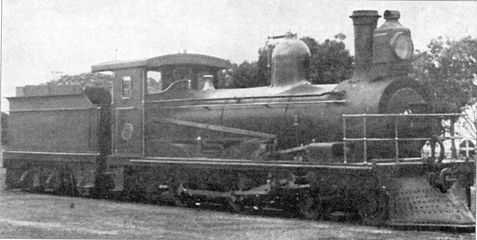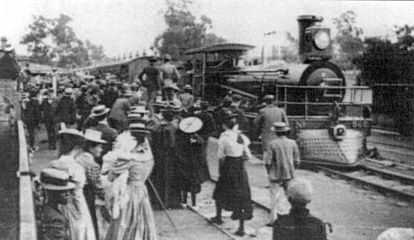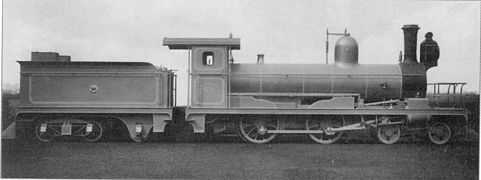CGR 3rd Class 4-4-0 1884
| CGR 3rd Class 4-4-0 1884 | |
|---|---|
|
Neilson works picture of the experimental 3rd Class 4-4-0 | |
| Type and origin | |
| Power type | Steam |
| Designer | Cape Government Railways |
| Builder | Neilson and Company |
| Serial number | 3080-3081 |
| Build date | 1883 |
| Total produced | 2 |
| Specifications | |
| Configuration | 4-4-0 "American" |
| Gauge | 3 ft 6 in (1,067 mm) Cape gauge |
| Leading wheel diameter | 27 1⁄2 in (699 mm) |
| Driver diameter | 48 3⁄4 in (1,240 mm) |
| Wheelbase |
6 ft 6 in (1.981 m) drivers 5 ft (1.524 m) bogie 17 ft 9 in (5.410 m) engine 4 ft 5 1⁄2 in (1.359 m) tender bogie 9 ft 3 in (2.819 m) tender 34 ft 11 1⁄2 in (10.655 m) total |
| Length | 46 ft 2 1⁄2 in (14.084 m) over couplers |
| Height | 12 ft (3.658 m) |
| Tender weight | 20 LT 2 cwt 1 qtr (20.4 t) |
| Tender type |
Fixed leading axle and one bogie 27 1⁄2 in (699 mm) wheel diameter |
| Fuel type | Coal |
| Fuel capacity | 5 long tons (5.1 t) |
| Water capacity | 1,700 imp gal (7,700 l; 2,000 US gal) |
| Boiler |
10 ft 4 1⁄2 in (3.162 m) length inside 6 ft (1.829 m) pitch |
| Boiler pressure | 130 psi (900 kPa) |
| Firegrate area | 18.25 sq ft (1.695 m2) |
| Heating surface: – Tubes |
143 tubes 1 3⁄4 in (44.4 mm) diameter 679.6 sq ft (63.137 m2) |
| – Firebox | 83.23 sq ft (7.732 m2) |
| – Total | 762.83 sq ft (70.869 m2) |
| Cylinders | Two |
| Cylinder size |
15 in (381 mm) bore 20 in (508 mm) stroke |
| Valve gear | Joy |
| Performance figures | |
| Tractive effort | 9,000 lbf (40 kN) at 75% pressure |
| Career | |
| Operator(s) | Cape Government Railways |
| Class | CGR 3rd Class |
| Number in class | 2 |
| Number(s) | E53-E54 |
| Delivered | 1884 |
| First run | 1884 [1][2] |
The CGR 3rd Class 4-4-0 of 1884 is a South African steam locomotive from the pre-Union era in the Cape Colony.
In 1884 the Cape Government Railways placed two experimental 3rd Class tender locomotives with a 4-4-0 American type wheel arrangement in service. They were designed by the Cape Eastern System to be able to use the low-grade local coal with its high content of incombustible matter.[1][2]
Stormberg coalfields
The extension of the Cape Government Railways (CGR) Eastern System's line from Queenstown reached Sterkstroom in 1883 and passed through the Stormberg coalfields where the Molteno and Cyphergat mines were operating.[1][3]
While the Colonial coal was much cheaper than imported coal, it had a non-combustable content of as high as 29%, which led to difficulties when used in locomotives since it frequently caused train delays to allow the firemen to clear the grate of clinker and ash. In attempts to overcome the problem, J.D. Tilney, the Eastern System's Locomotive Superintendent, carried out many experiments on some of the 4th Class 4-6-0TT locomotives that had entered service on the Eastern System in 1880, chief of which involved modifying the boilers and frames to accommodate oscillating firebars and larger fireboxes.[1]
Manufacturer
Based on the results of Tilney's experiments, complete sets of drawings for a 4-4-0 American type tender passenger locomotive as well as a 4-6-0 Tenwheeler type tank-and-tender goods locomotive were prepared at the CGR's Salt River shops in 1882 and submitted to Neilson and Company for the construction of two 4-4-0 and four 4-6-0 locomotives.[1][2]
The 4-4-0 locomotives entered service in 1884, numbered E53 and E54 for the Eastern System. No. E54 was delivered to the Eastern system, but no. E53 was initially delivered to the Western System for evaluation and testing by Locomotive Superintendent Thornton.[1][2]
The design of the two types was also an early attempt at standardisation, since the boilers and tenders and many other parts were made interchangeable. The three-axle tender was unusual since the leading axle was mounted in a rigid frame while the other two were mounted in a bogie. This was the first time that a bogie was used under a tender in South Africa, but also the only time that this tender wheel arrangement was used on the CGR. This peculiar tender wheel arrangement appeared in South Africa on only one other occasion, eighteen years later on the Baldwin-built Zululand Railway Company 2-6-0 locomotive in Natal.[1]
Service
The locomotives gave good results in service, but were difficult to fire due to their very long and narrow grates. When better quality coal that was more suitable for use in the standard locomotives began to become available from the coalfields in Natal, no more locomotives of this experimental design were ordered.[1]
Both locomotives were renumbered by 1886, when the system number prefixes were done away with and the Eastern System's locomotives were renumbered into the 600 number range. No. E53 became no. 645 and no. E54 became no. 646. Neither entered South African Railways service since both were withdrawn from CGR service between 1900 and 1910.[1][2]
The pictures below are possibly the only ones in existence of the locomotive in service.[4]
-

No. 646 at King William's Town on 7 November 1899
-

No. 646 in King William's Town station, November 1899
See also
- CGR 3rd Class 4-4-0 1883
- CGR 3rd Class 4-4-0 1889
- CGR 3rd Class 4-4-0 1898
- CGR 3rd Class 4-4-0 1901
- CGR 3rd Class 4-4-0 1903
- List of South African locomotive classes
- South African locomotive history
- The 4-4-0 "American"
References
|
- ↑ 1.0 1.1 1.2 1.3 1.4 1.5 1.6 1.7 1.8 Holland, D.F. (1971). Steam Locomotives of the South African Railways, Volume 1: 1859-1910 (1st ed.). Newton Abbott, Devon: David & Charles. pp. 35–36. ISBN 978-0-7153-5382-0.
- ↑ 2.0 2.1 2.2 2.3 2.4 C.G.R. Numbering Revised, Article by Dave Littley, SA Rail May–June 1993, pp. 94-95.
- ↑ The South African Railways - Historical Survey. Editor George Hart, Publisher Bill Hart, Sponsored by Dorbyl Ltd., Published c. 1978, pp. 12-13.
- ↑ Dulez, Jean A. (2012). Railways of Southern Africa 150 Years (Commemorating One Hundred and Fifty Years of Railways on the Sub-Continent - Complete Motive Power Classifications and Famous Trains - 1860-2011) (1st ed.). Garden View, Johannesburg, South Africa: Vidrail Productions. p. 22. ISBN 9 780620 512282.
